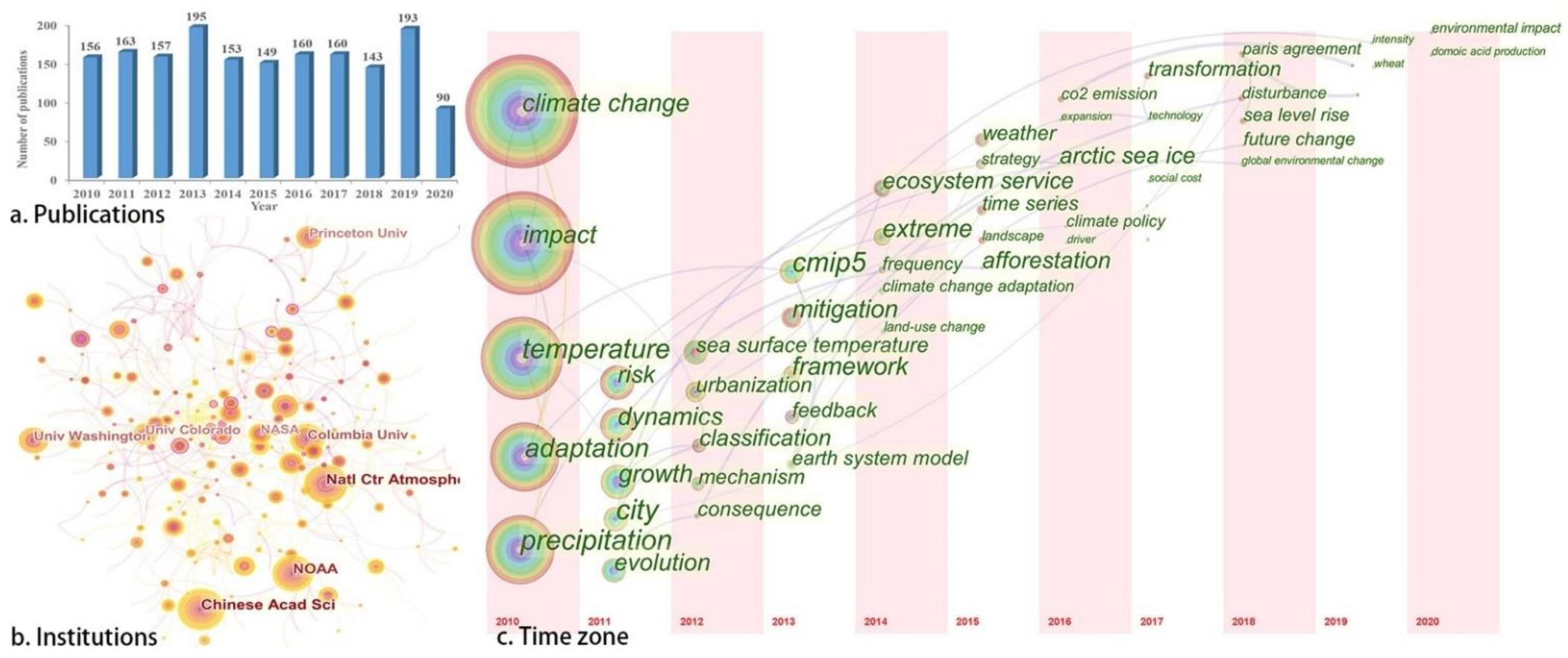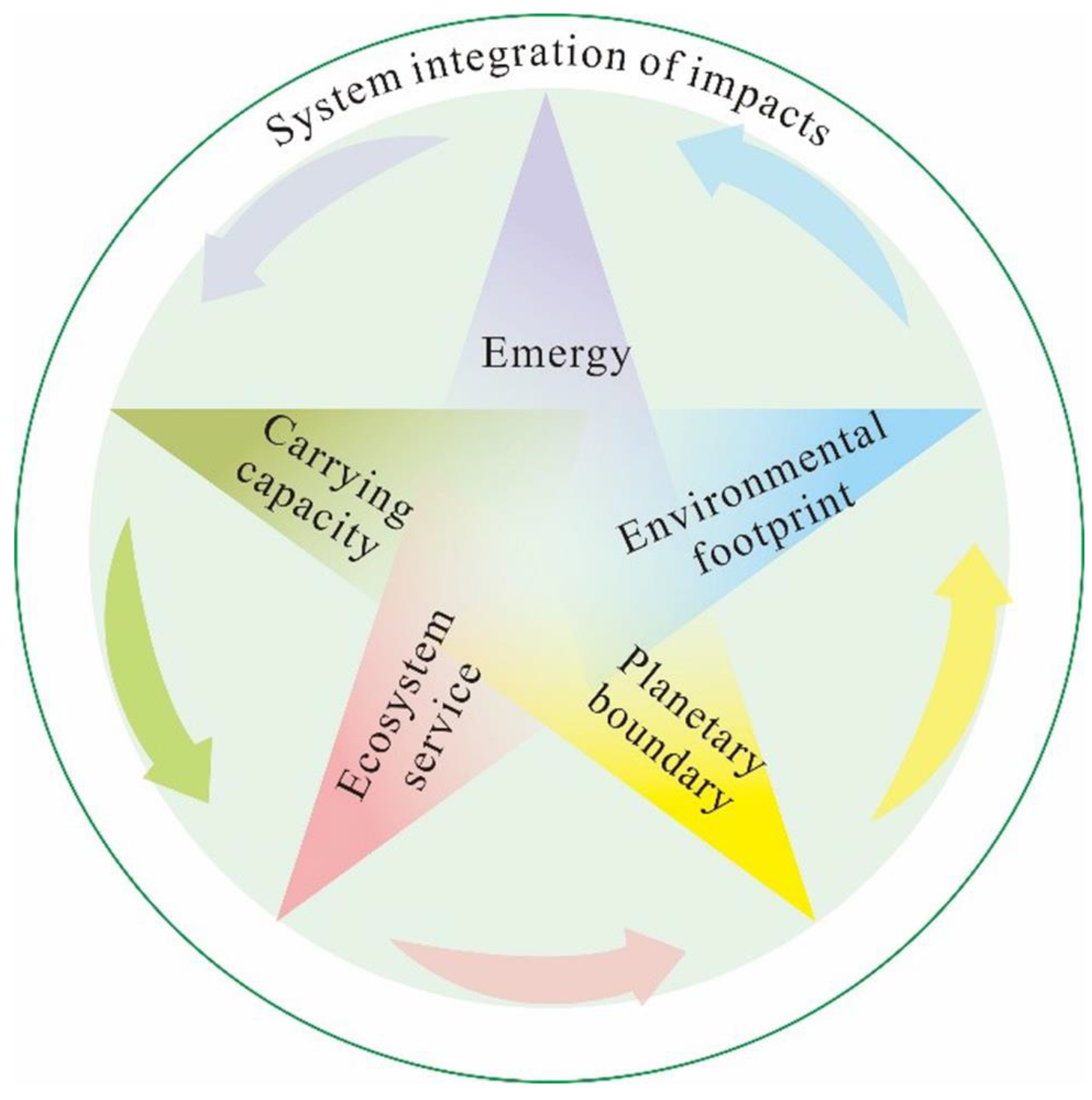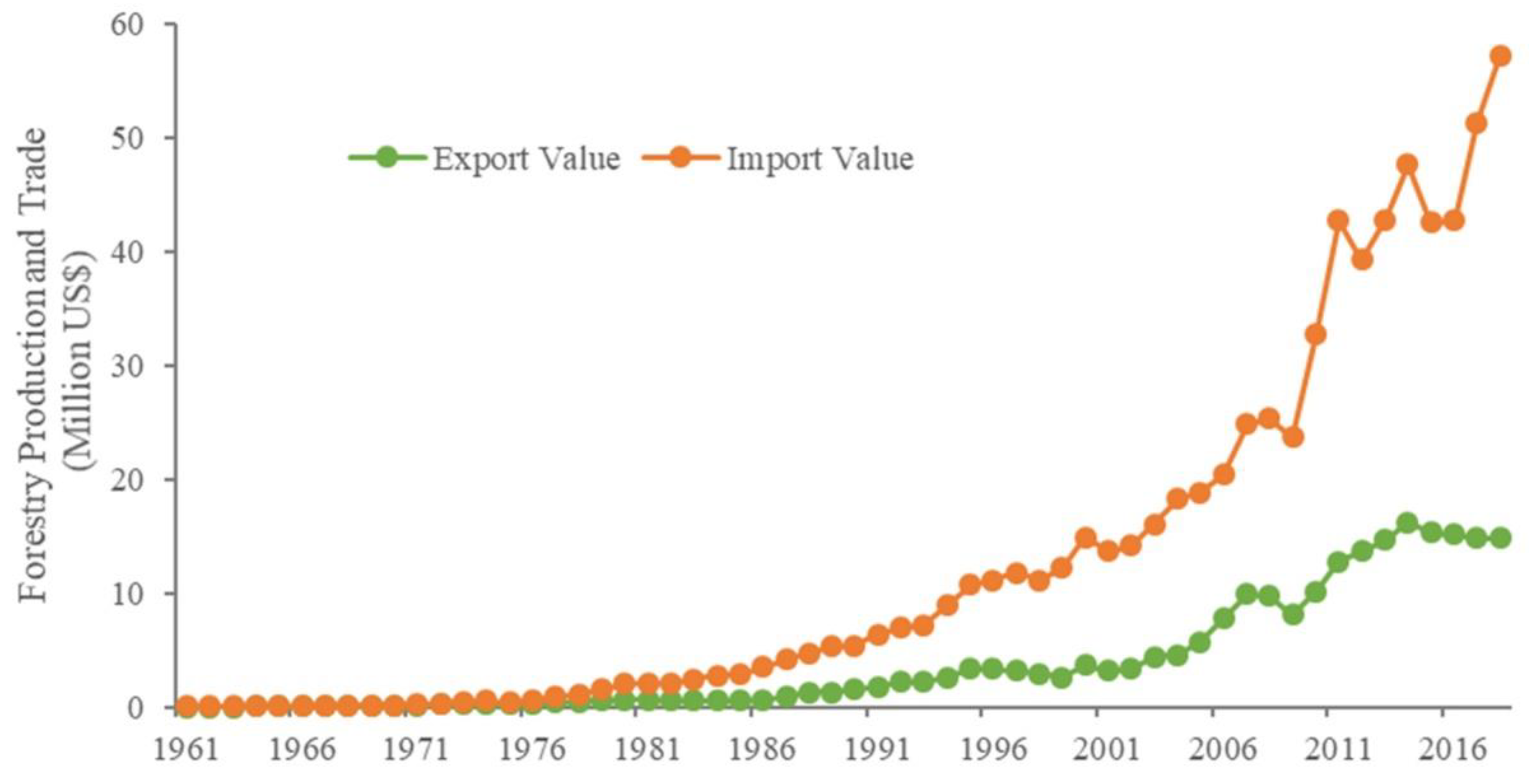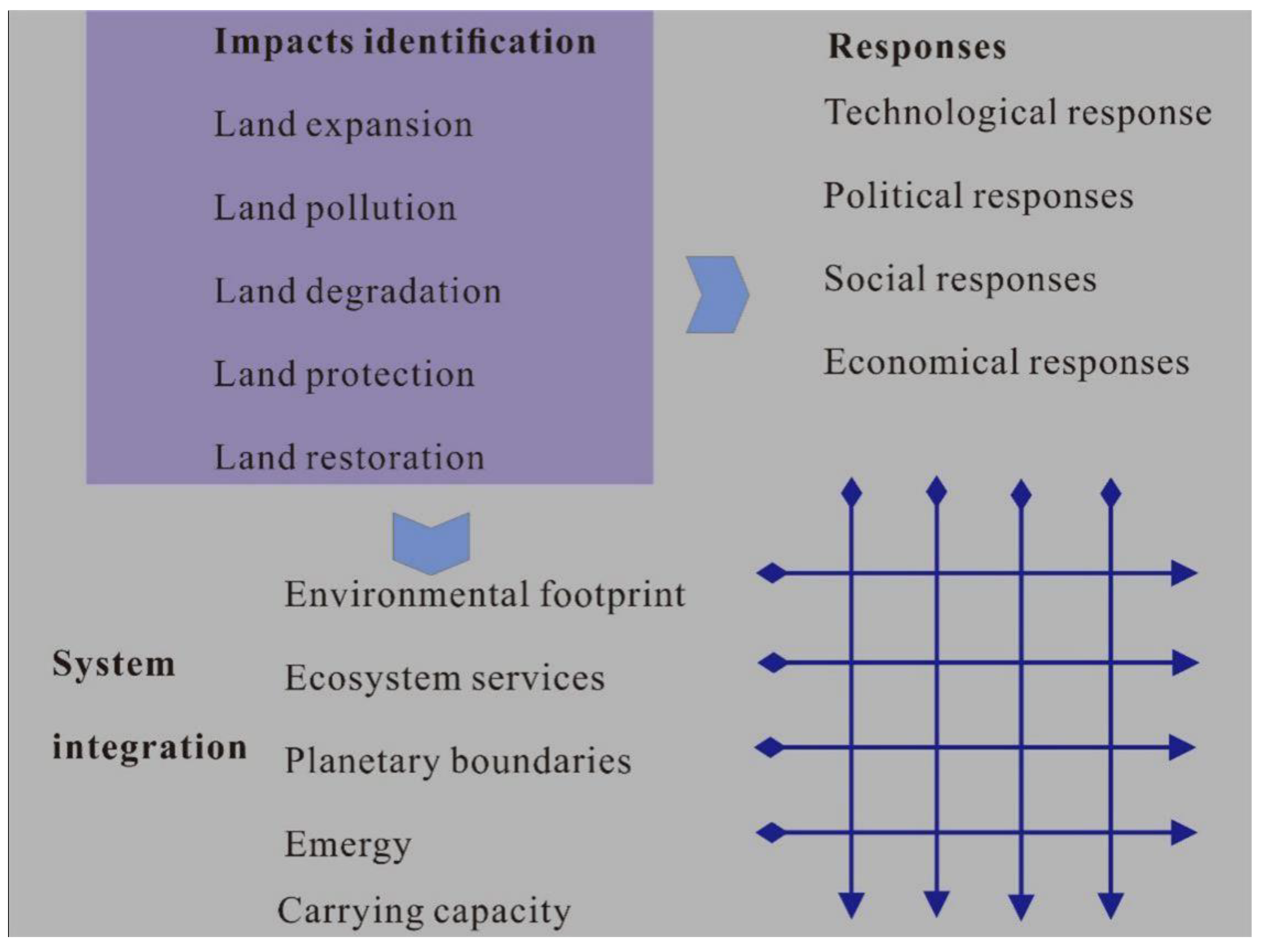Achieving Win–Win Solutions in Telecoupled Human–Land Systems
Abstract
:1. Introduction
2. Methodology
2.1. Data Source
2.2. CiteSpace
2.3. Analysis
3. Results
3.1. Overview of Results Based on CiteSpace
3.2. Impacts of Telecoupling on Land
3.2.1. Impacts of Telecoupling on Land Expansion
3.2.2. Impacts of Telecoupling on Land Pollution
3.2.3. Impacts of Telecoupling on Land Degradation
3.2.4. Impacts of Telecoupling on Land Protection and Restoration
3.3. System Integration of the Telecoupled Impacts
3.4. Responses to Telecoupling for Sustainable Land Use
| Responses | Concrete Approaches | Cases |
|---|---|---|
| Technological | Technology transfer and upgrade; recycling technology; applying and developing renewable energy | Using biogas and solar energy to alleviate rocky desertification in Southwest China [67] |
| Political | Institutional organizations, sectors or bodies; policy instruments and targets (international treaties, national laws and regulations, international bilateral and multilateral treaties); implementation strategy (polycentric governance) | Polycentric governance in Sierra Leone to ensure the rational use of land [68] |
| Social | Encouraging the use of local resources; respecting indigenous and local knowledge (ILK); increase of mobility and migration | Waste deposition practices boost soil carbon accumulation [69] |
| Economical | Payment for ecosystem services (PES); reducing poverty; economic, livelihood, and crop production diversification | PES in Mexico to prevent deforestation [70] |
3.4.1. Technical Responses
3.4.2. Policy Responses
3.4.3. Social Responses
3.4.4. Economic Responses
4. Discussion
4.1. Framework to Achieve a Win–Win Situation for Telecoupled Human–Land Systems
4.2. Future Prospects
5. Conclusions
Author Contributions
Funding
Data Availability Statement
Conflicts of Interest
References
- IPBES. The IPBES Assessment Report on Land Degradation and Restoration; Montanarella, L., Scholes, R., Brainich, A., Eds.; Secretariat of the Intergovernmental Science-Policy Platform on Biodiversity and Ecosystem Services: Bonn, Germany, 2018. [Google Scholar]
- Liu, J.; Hull, V.; Batistella, M.; DeFries, R.; Dietz, T.; Fu, F.; Hertel, T.W.; Izaurralde, R.C.; Lambin, E.F.; Li, S.; et al. Framing sustainability in a telecoupled world. Ecol. Soc. 2013, 18. [Google Scholar] [CrossRef]
- Liu, J.; Herzberger, A.; Kapsar, K.; Carlson, A.K.; Connor, T. What Is Telecoupling? In Telecoupling: Exploring Land-Use Change in a Globalised World; Friis, C., Nielsen, J.Ø., Eds.; Springer International Publishing: Cham, Switzerland, 2019; pp. 19–48. [Google Scholar] [CrossRef]
- Wallace, J.; Gutzler, D. Teleconnections in the Geopotential Height Field during the Northern Hemisphere Winter. Mon. Wea. Rev. 1981, 109, 784–812. [Google Scholar] [CrossRef]
- Sassen, S. Globalisation and Its Discontents: Essays on the New Mobility of People and Money; The New Press: New York, NY, USA, 1999. [Google Scholar]
- Wang, F.; Liu, J. Conservation planning beyond giant pandas: The need for an innovative telecoupling framework. Sci. China Life Sci. 2017, 60, 551–554. [Google Scholar] [CrossRef] [PubMed] [Green Version]
- Moran, E.F. Environmental Social Science: Human-Environment Interactions and Sustainability. Int. J. Soc. Res. Methodol. 2012, 10, 445–450. [Google Scholar]
- Shaver, I.; Chain-Guadarrama, A.; Cleary, K.A.; Sanfiorenzo, A.; Santiago-García, R.J.; Finegan, B.; Hormel, L.; Sibelet, N.; Vierling, L.A.; Bosque-Pérez, N.A. Coupled social and ecological outcomes of agricultural intensification in Costa Rica and the future of biodiversity conservation in tropical agricultural regions. Glob. Environ. Chang. 2015, 32, 74–86. [Google Scholar] [CrossRef]
- Yao, G.; Hertel, T.W.; Taheripour, F. Economic drivers of telecoupling and terrestrial carbon fluxes in the global soybean complex. Glob. Environ. Chang. 2018, 50, 190–200. [Google Scholar] [CrossRef]
- Liu, J.; Dietz, T.; Carpenter, S.R.; Folke, C.; Alberti, M.; Redman, C.L.; Schneider, S.H.; Ostrom, E.; Pell, A.N.; Lubchenco, J.; et al. Coupled Human and Natural Systems. AMBIO A J. Hum. Environ. 2007, 36, 639–649. [Google Scholar] [CrossRef]
- Friis, C.; Nielsen, J.Ø.; Otero, I.; Haberl, H.; Niewöhner, J.; Hostert, P. From teleconnection to telecoupling: Taking stock of an emerging framework in land system science. J. Land Use Sci. 2015, 11, 131–153. [Google Scholar] [CrossRef]
- Lenschow, A.; Newig, J.; Challies, E. Globalization’s limits to the environmental state? Integrating telecoupling into global environmental governance. Environ. Politics 2015, 25, 136–159. [Google Scholar] [CrossRef]
- Friis, C.; Nielsen, J.Ø. Land-use change in a telecoupled world: The relevance and applicability of the telecoupling framework in the case of banana plantation expansion in Laos. Ecol. Soc. 2017, 22, 30. [Google Scholar] [CrossRef]
- Leisz, S.; Rounds, E.; An, N.; Nguyen, T.B.Y.; Nguyen Bang, T.; Douangphachanh, S.; Ninchaleune, B. Telecouplings in the East-West Economic Corridor within Borders and Across. Remote Sens. 2016, 8, 1012. [Google Scholar] [CrossRef] [Green Version]
- Liu, J. Forest sustainability in china and implications for a telecoupled world. Asia Pac. Policy Stud. 2014, 1, 230–250. [Google Scholar] [CrossRef] [Green Version]
- Liu, J.; Yang, W.; Li, S. Framing ecosystem services in the telecoupled Anthropocene. Front. Ecol. Environ. 2016, 14, 27–36. [Google Scholar] [CrossRef]
- UN. The United Nations Sustainable Development Goals. Available online: https://www.un.org/sustainabledevelopment/ (accessed on 12 October 2020).
- McCord, P.; Tonini, F.; Liu, J. The Telecoupling GeoApp: A Web-GIS application to systematically analyze telecouplings and sustainable development. Appl. Geogr. 2018, 96, 16–28. [Google Scholar] [CrossRef]
- Zaehringer, J.G.; Schneider, F.; Heinimann, A.; Messerli, P. Co-producing knowledge for sustainable development in telecoupled land systems. In Telecoupling: Exploring Land-Use Change in a Globalised World; Friis, C., Nielsen, J.Ø., Eds.; Springer International Publishing: Cham, Switzerland, 2019; pp. 357–381. [Google Scholar] [CrossRef]
- Liu, J.; Mooney, H.; Hull, V.; Davis, S.J.; Gaskell, J.; Hertel, T.; Lubchenco, J.; Seto, K.C.; Gleick, P.; Kremen, C. Sustainability. Systems integration for global sustainability. Science 2015, 347, 1258832. [Google Scholar] [CrossRef] [PubMed] [Green Version]
- Komiyama, H.; Takeuchi, K. Sustainability science: Building a new discipline. Sustain. Sci. 2006, 1, 1–6. [Google Scholar] [CrossRef]
- Turner, B.L.; Kasperson, R.E.; Matson, P.A.; McCarthy, J.J.; Corell, R.W.; Christensen, L.; Eckley, N.; Kasperson, J.X.; Luers, A.; Martello, M.L.; et al. A framework for vulnerability analysis in sustainability science. Proc. Natl. Acad. Sci. USA 2003, 100, 8074–8079. [Google Scholar] [CrossRef] [PubMed] [Green Version]
- Polsky, C.; Neff, R.; Yarnal, B. Building comparable global change vulnerability assessments: The vulnerability scoping diagram. Glob. Environ. Chang. 2007, 17, 472–485. [Google Scholar] [CrossRef]
- Liu, J.; Dou, Y.; Batistella, M.; Challies, E.; Connor, T.; Friis, C.; Millington, J.D.A.; Parish, E.; Romulo, C.L.; Silva, R.F.B.; et al. Spillover systems in a telecoupled Anthropocene: Typology, methods, and governance for global sustainability. Curr. Opin. Environ. Sustain. 2018, 33, 58–69. [Google Scholar] [CrossRef] [Green Version]
- Eakin, H.; Defries, R.; Kerr, S.; Lambin, E.F.; Liu, J.; Marcotullio, P.J.; Messerli, P.; Reenberg, A.; Rueda, X.; Swaffield, S.R.; et al. Significance of telecoupling for exploration of land use change. In Rethinking Global Land Use in an Urban Era; MIT Press Scholarship Online: Cambridge, MA, USA, 2014. [Google Scholar] [CrossRef]
- Zhang, D.; Xu, J.; Zhang, Y.; Wang, J.; He, S.; Zhou, X. Study on sustainable urbanization literature based on Web of Science, scopus, and China national knowledge infrastructure: A scientometric analysis in CiteSpace. J. Clean. Prod. 2020, 264, 121537. [Google Scholar] [CrossRef]
- Wu, Y.; Wang, H.; Wang, Z.; Zhang, B.; Meyer, B.C. Knowledge Mapping Analysis of Rural Landscape Using CiteSpace. Sustainability 2019, 12, 66. [Google Scholar] [CrossRef] [Green Version]
- Scheffer, M.; Barrett, S.; Carpenter, S.R.; Folke, C.; Green, A.J.; Holmgren, M.; Hughes, T.P.; Kosten, S.; van de Leemput, I.A.; Nepstad, D.C.; et al. Climate and conservation. Creating a safe operating space for iconic ecosystems. Science 2015, 347, 1317–1319. [Google Scholar] [CrossRef] [Green Version]
- Zhu, L. The Construction Model. of “One Belt and One Road”: Mechanisms and Platforms; Springer: Singapore, 2016. [Google Scholar]
- Palit, A. India’s Economic and Strategic Perceptions of China’s Maritime Silk Road Initiative. Geopolitics 2017, 22, 292–309. [Google Scholar] [CrossRef]
- Chen, L.; Zhang, W. China OBOR in Perspective of High-speed Railway (HSR)—Research on OBOR Economic Expansion Strategy of China. Adv. Econ. Bus. 2015, 3, 303–321. [Google Scholar]
- Wang, J.; Huang, Z. Analysis and forecast of regional freight characteristics in the silk road economic belt. In InInformation Technology and Intelligent Transportation Systems; Balas, V., Jain, L., Zhao, X., Eds.; Advances in Intelligent Systems and Computing; Springer: Cham, Switzerland, 2017; Volume 455, pp. 53–63. [Google Scholar]
- Shao, Z.Z.; Ma, Z.J.; Sheu, J.B.; Gao, H.O. Evaluation of large-scale transnational high-speed railway construction priority in the belt and road region. Transp. Res. Part E Logist. Transp. Rev. 2018, 117, 40–57. [Google Scholar] [CrossRef]
- Laurance, W.F.; Sayer, J.; Cassman, K.G. Agricultural expansion and its impacts on tropical nature. Trends Ecol. Evol. 2014, 29, 107–116. [Google Scholar] [CrossRef]
- Chen, Y. China’s Role in Nigerian Railway Development and Implications for Security and Development; US Institute of Peace: Washington, DC, USA, 2018. [Google Scholar]
- Lenzen, M.; Moran, D.; Kanemoto, K.; Foran, B.; Lobefaro, L.; Geschke, A. International trade drives biodiversity threats in developing nations. Nature 2012, 486, 109–112. [Google Scholar] [CrossRef] [PubMed]
- Galloway, J.N.; Burke, M.; Bradford, G.E.; Naylor, R.; Falcon, W.; Chapagain, A.K.; Gaskell, J.C.; McCullough, E.; Mooney, H.A.; Oleson, K.L.L. International Trade in Meat: The Tip of the Pork Chop. Ambio 2007, 36, 622–629. [Google Scholar] [CrossRef] [Green Version]
- Matlhola, D.M.; Chen, R. Telecoupling of the Trade of Donkey-Hides between Botswana and China: Challenges and Opportunities. Sustainability 2020, 12, 1730. [Google Scholar] [CrossRef] [Green Version]
- Brooks, A.; Wang, S.; Jambeck, J. The Chinese import ban and its impact on global plastic waste trade. Sci. Adv. 2018, 4. [Google Scholar] [CrossRef] [Green Version]
- Wood, R.; Stadler, K.; Simas, M.; Bulavskaya, T.; Giljum, S.; Lutter, S.; Tukker, A. Growth in Environmental Footprints and Environmental Impacts Embodied in Trade: Resource Efficiency Indicators from EXIOBASE3. J. Ind. Ecol. 2018. [Google Scholar] [CrossRef] [Green Version]
- Kissinger, G.M.; Herold, M.; De Sy, V. Drivers of Deforestation and Forest Degradation: A Synthesis Report for REDD+ Policymakers; Lexeme Consulting: Vancouver, BC, Canada, 2012. [Google Scholar]
- Morton, D.C.; DeFries, R.S.; Shimabukuro, Y.E.; Anderson, L.O.; Arai, E.; del Bon EspiritoSanto, F.; Freitas, R.; Morisette, J. Cropland expansion changes deforestation dynamics in the southern Brazilian Amazon. Proc. Natl. Acad. Sci. USA 2006, 103, 14637–14641. [Google Scholar] [CrossRef] [PubMed] [Green Version]
- Silva, R.F.B.D.; Batistella, M.; Dou, Y.; Moran, E.; Torres, S.M.; Liu, J. The Sino-Brazilian Telecoupled Soybean System and Cascading Effects for the Exporting Country. Land 2017, 6, 53. [Google Scholar] [CrossRef] [Green Version]
- Richards, P.D.; Walker, R.T.; Arima, E.Y. Spatially complex land change: The Indirect effect of Brazil’s agricultural sector on land use in Amazonia. Glob. Environ. Chang. Hum. Policy Dimens. 2014, 29, 1–9. [Google Scholar] [CrossRef] [PubMed] [Green Version]
- Fehlenberg, V.; Baumann, M.; Gasparri, N.I.; Piquer-Rodriguez, M.; Gavier-Pizarro, G.; Kuemmerle, T. The role of soybean production as an underlying driver of deforestation in the South American Chaco. Glob. Environ. Chang. 2017, 45, 24–34. [Google Scholar] [CrossRef]
- Vijay, V.; Pimm, S.L.; Jenkins, C.N.; Smith, S.J. The Impacts of Oil Palm on Recent Deforestation and Biodiversity Loss. PLoS ONE 2016, 11, e0159668. [Google Scholar] [CrossRef] [PubMed]
- Defries, R.S.; Rudel, T.; Uriarte, M.; Hansen, M. Deforestation driven by urban population growth and agricultural trade in the twenty-first century. Nat. Geosci. 2010, 3, 178–181. [Google Scholar] [CrossRef]
- Du, X.; Graedel, T.E. Global In-Use Stocks of the Rare Earth Elements: A First Estimate. Environ. Sci. Technol. 2011, 45, 4096–4101. [Google Scholar] [CrossRef]
- Ross, M.R.; Mcglynn, B.L.; Bernhardt, E.S. Deep impact: Effects of mountaintop mining on surface topography, bedrock structure, and downstream waters. Environ. Sci. Technol. 2016, 50, 2064. [Google Scholar] [CrossRef] [Green Version]
- Trujillo, E. China—Measures Related to the Exportation of Rare Earths, Tungsten, and Molybdenum. Am. J. Int. Law 2015, 109, 616–623. [Google Scholar] [CrossRef]
- Chen, C.; Park, T.; Wang, X.; Piao, S.; Xu, B.; Chaturvedi, R.K.; Fuchs, R.; Brovkin, V.; Ciais, P.; Fensholt, R.; et al. China and India lead in greening of the world through land-use management. Nat. Sustain. 2019, 2, 122–129. [Google Scholar] [CrossRef] [PubMed]
- UNCCD. UNCCD Announces 2015 Winners of Land for Life Award. Available online: https://www.unccd.int/news-events/unccd-announces-2015-winners-land-life-award (accessed on 1 March 2020).
- Guo, X.; Chen, R.; Thomas, D.; Li, Q.; Xia, Z.; Pan, Z. Divergent processes and trends of desertification in Inner Mongolia and Mongolia. Land Degrad. Dev. 2020. [Google Scholar] [CrossRef]
- Dudley, N.; Gonzales, E.; Keenleyside, K.; Mumba, M.; Hallett, J. The UN Decade on Ecosystem Restoration (2021–2030): What can protected areas contribute? Parks 2020, 26, 111–116. [Google Scholar] [CrossRef]
- Maseyk, F.; Barea, L.P.; Stephens, R.; Possingham, H.P.; Dutson, G.; Maron, M. A disaggregated biodiversity offset accounting model to improve estimation of ecological equivalency and no net loss. Biol. Conserv. 2016, 204, 322–332. [Google Scholar] [CrossRef] [Green Version]
- Yu, S.; Cui, B.; Gibbons, P.; Yan, J.; Ma, X.; Xie, T.; Song, G.; Zou, Y.; Shao, X. Towards a biodiversity offsetting approach for coastal land reclamation: Coastal management implications. Biol. Conserv. 2017, 214, 35–45. [Google Scholar] [CrossRef]
- Hoekstra, A.Y.; Wiedmann, T.O. Humanity’s unsustainable environmental footprint. Science 2014, 344, 1114–1117. [Google Scholar] [CrossRef] [PubMed]
- Rockström, J.; Steffen, W.; Noone, K.; Persson, Å.; Chapin Iii, F.S.; Lambin, E.; Lenton, T.; Scheffer, M.; Folke, C.; Schellnhuber, H.; et al. Planetary Boundaries: Exploring the Safe Operating Space for Humanity. Ecol. Soc. 2009, 14. [Google Scholar] [CrossRef]
- Odum, H.T. Environmental accounting: EMERGY and environmental decision making. Child. Dev. 1996, 42, 1187–1201. [Google Scholar]
- Schröter, M.; Koellner, T.; Alkemade, R.; Arnhold, S.; Bagstad, K.J.; Erb, K.H.; Frank, K.; Kastner, T.; Kissinger, M.; Liu, J. Interregional flows of ecosystem services: Concepts, typology and four cases. Ecosyst. Serv. 2018, 31, 231–241. [Google Scholar] [CrossRef]
- Bagstad, K.J.; Johnson, G.W.; Voigt, B.; Villa, F. Spatial dynamics of ecosystem service flows: A comprehensive approach to quantifying actual services. Ecosyst. Serv. 2013, 4, 117–125. [Google Scholar] [CrossRef]
- Owuor, M.A.; Icely, J.; Newton, A.; Nyunja, J.; Otieno, P.; Tuda, A.O.; Oduor, N. Mapping of ecosystem services flow in Mida Creek, Kenya. Ocean. Coast. Manag. 2017, 140, 11–21. [Google Scholar] [CrossRef]
- Semmens, D.J.; Diffendorfer, J.E.; Bagstad, K.J.; Wiederholt, R.; Oberhauser, K.; Ries, L.; Semmens, B.X.; Goldstein, J.; Loomis, J.; Thogmartin, W.E. Quantifying ecosystem service flows at multiple scales across the range of a long-distance migratory species. Ecosyst. Serv. 2018, 31, 255–264. [Google Scholar] [CrossRef]
- Challies, E.; Newig, J.; Lenschow, A. Governance for Sustainability in Telecoupled Systems. In Telecoupling. Palgrave Studies in Natural Resource Management; Friis, C., Nielsen, J., Eds.; Palgrave Macmillan: Cham, Switzerland, 2019; pp. 177–197. [Google Scholar] [CrossRef]
- Hanspach, J.; Abson, D.J.; French Collier, N.; Dorresteijn, I.; Schultner, J.; Fischer, J. From trade-offs to synergies in food security and biodiversity conservation. Front. Ecol. Environ. 2017, 15, 489–494. [Google Scholar] [CrossRef]
- Wang, L.; Zheng, H.; Wen, Z.; Liu, L.; Robinson, B.E.; Li, R.; Li, C.; Kong, L. Ecosystem service synergies/trade-offs informing the supply-demand match of ecosystem services: Framework and application. Ecosyst. Serv. 2019, 37, 100939. [Google Scholar] [CrossRef]
- Jiang, Z.; Lian, Y.; Qin, X. Rocky desertification in Southwest China: Impacts, causes, and restoration. Earth Sci. Rev. 2014, 132, 1–12. [Google Scholar] [CrossRef]
- Oberlack, C.; Boillat, S.; Brönnimann, S.; Gerber, J.D.; Heinimann, A.; Speranza, C.I.; Messerli, P.; Rist, S.; Wiesmann, U. Polycentric governance in telecoupled resource systems. Ecol. Soc. 2017, 23, 16. [Google Scholar] [CrossRef] [Green Version]
- Solomon, D.; Lehmann, J.; Fraser, J.A.; Leach, M.; Amanor, K.; Frausin, V.; Kristiansen, S.M.; Millimouno, D.; Fairhead, J. Indigenous African soil enrichment as a climate-smart sustainable agriculture alternative. Front. Ecol. Environ. 2016, 14, 71–76. [Google Scholar] [CrossRef] [Green Version]
- Alixgarcia, J.M.; Shapiro, E.N.; Sims, K.R.E. Forest conservation and slippage: Evidence from Mexico’s national payments for ecosystem services program. Staff Paper 2012, 88, 613–638. [Google Scholar]
- Bryan, B.A.; Gao, L.; Ye, Y.; Sun, X.; Connor, J.D.; Crossman, N.D.; Stafford-Smith, M.; Wu, J.; He, C.; Yu, D.; et al. China’s response to a national land-system sustainability emergency. Nature 2018, 559, 193–204. [Google Scholar] [CrossRef]
- Eshun, J.F.; Potting, J.; Leemans, R. Wood waste minimization in the timber sector of Ghana: A systems approach to reduce environmental impact. J. Clean. Prod. 2012, 26, 67–78. [Google Scholar] [CrossRef]
- Liu, W.M.; Luk, M.K.R. Reform and opening up: Way to the sustainable and harmonious development of air transport in China. Transp. Policy 2009, 16, 215–223. [Google Scholar] [CrossRef]
- Giamporcaro, S.; Pretorius, L. Sustainable and responsible investment (SRI) in South Africa: A limited adoption of environmental criteria. Invest. Anal. J. 2015, 41, 1–19. [Google Scholar] [CrossRef]
- Amugune, I.; Cerutti, P.; Baral, H.; Leonard, S.; Martius, C. Small Flame but No Fire: Wood Fuel in the (Intended) Nationally Determined Contributions of Countries in Sub-Saharan Africa; Working Paper 232; CIFOR: Bogor, Indonesia, 2017. [Google Scholar]
- Stambouli, A.B.; Khiat, Z.; Flazi, S.; Kitamura, Y. A review on the renewable energy development in Algeria: Current perspective, energy scenario and sustainability issues. Renew. Sustain. Energy Rev. 2012, 16, 4445–4460. [Google Scholar] [CrossRef]
- UNCCD. COP14: 2–13 September New Delhi, India. Available online: https://www.unccd.int/conventionconference-parties-cop/cop14-2-13-september-new-delhi-india (accessed on 1 May 2020).
- Pattberg, P. Public-private partnerships in global climate governance. Wiley Interdiscip. Rev. Clim. Chang. 2010, 1, 279–287. [Google Scholar] [CrossRef]
- Reinecke, S.; Pistorius, T.; Pregernig, M. UNFCCC and the REDD+ Partnership from a networked governance perspective. Environ. Sci. Policy 2014, 35, 30–39. [Google Scholar] [CrossRef]
- Engelhaupt, E. Do food miles matter? Environ. Sci. Technol. 2008, 42, 3482. [Google Scholar] [CrossRef] [PubMed] [Green Version]
- Weber, C.L.; Matthews, H.S. Food-miles and the relative climate impacts of food choices in the United States. Environ. Sci. Technol. 2008, 42, 3508–3513. [Google Scholar] [CrossRef] [Green Version]
- Babai, D.; Molnár, Z. Small-scale traditional management of highly species-rich grasslands in the Carpathians. Agric. Ecosyst. Environ. 2014, 182, 123–130. [Google Scholar] [CrossRef]
- Reyes-García, V.; Fernández-Llamazares, Á.; McElwee, P.; Molnár, Z.; Öllerer, K.; Wilson, S.J.; Brondizio, E.S. The contributions of Indigenous Peoples and local communities to ecological restoration. Restor. Ecol. 2019, 27, 3–8. [Google Scholar] [CrossRef] [Green Version]
- Aide, T.M.; Muñiz, M. Deforestation and Reforestation of Latin America and the Caribbean (2001–2010). Biotropica 2013, 45, 262–271. [Google Scholar] [CrossRef]
- Chen, R.; Ye, C.; Cai, Y.; Xing, X.; Chen, Q. The impact of rural out-migration on land use transition in China: Past, present and trend. Land Use Policy 2014, 40, 101–110. [Google Scholar] [CrossRef]
- Turpie, J.K.; Marais, C.; Blignaut, J.N.; Wunder, S.; Engel, S.; Pagiola, S. The working for water programme: Evolution of a payments for ecosystem services mechanism that addresses both poverty and ecosystem service delivery in South Africa. Ecol. Econ. 2008, 65, 788–798. [Google Scholar] [CrossRef] [Green Version]
- Deng, L.; Shangguan, Z.-P.; Li, R. Effects of the Grain-for-Green Program on Soil Erosion in China. Int. J. Sediment Res. 2012, 27, 120–127. [Google Scholar] [CrossRef]
- Barrett, C.B.; Christiaensen, L.; Sheahan, M.; Shimeles, A. On the structural transformation of rural Africa. Policy Res. Work. Paper 2017, 26, i11–i35. [Google Scholar]
- Burch, S.; Gupta, A.; Inoue, C.Y.A.; Kalfagianni, A.; Persson, Å.; Gerlak, A.K.; Ishii, A.; Patterson, J.; Pickering, J.; Scobie, M.; et al. New directions in earth system governance research. Earth Syst. Gov. 2019, 1, 100006. [Google Scholar] [CrossRef]





Publisher’s Note: MDPI stays neutral with regard to jurisdictional claims in published maps and institutional affiliations. |
© 2021 by the authors. Licensee MDPI, Basel, Switzerland. This article is an open access article distributed under the terms and conditions of the Creative Commons Attribution (CC BY) license (http://creativecommons.org/licenses/by/4.0/).
Share and Cite
Guo, X.; Chen, R.; Li, Q.; Meadows, M.E. Achieving Win–Win Solutions in Telecoupled Human–Land Systems. Land 2021, 10, 272. https://doi.org/10.3390/land10030272
Guo X, Chen R, Li Q, Meadows ME. Achieving Win–Win Solutions in Telecoupled Human–Land Systems. Land. 2021; 10(3):272. https://doi.org/10.3390/land10030272
Chicago/Turabian StyleGuo, Xiaona, Ruishan Chen, Qiang Li, and Michael E. Meadows. 2021. "Achieving Win–Win Solutions in Telecoupled Human–Land Systems" Land 10, no. 3: 272. https://doi.org/10.3390/land10030272






